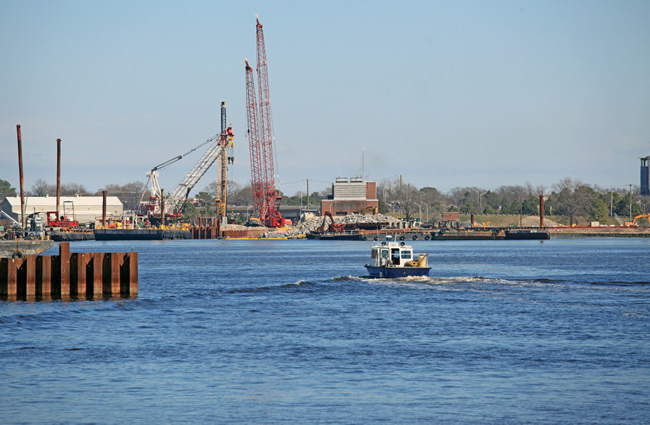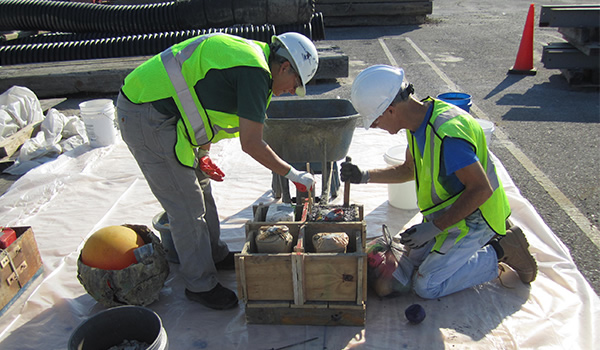Infrastructure projects often shape our futures for the better, but they can also be tremendous sources of pollution—especially without proper attention to erosion and sediment control—and lead to poor relations with a community for a project’s stakeholders. How do we improve these relationships? How do we create strong environmental programs on construction sites? How do we give communities a sense of ownership of the projects? In this week’s Geotalk Podcast, Carissa Agnese shares her experience with managing environmental programs on Skanska USA’s work sites in the Southeastern United States, where they’ve achieved some impressive, award-winning results.
Listen to “How to Create Strong Environmental Programs on a Construction Site” on Spreaker.
Agnese’s strategies involve getting buy-in from everyone in the process. This includes workers picking up trash on a site, company vice presidents overseeing budget lines, local environmental groups, and more.
We interviewed her during the International Erosion Control Association 2017 conference and exhibition, and we encourage readers to check out the latest information on IECA 2018, which will take place February 11 – 14 in Long Beach, California.
GeoTalk is published on Tuesdays. Recent episodes:
- August 15: Proper Drainage and Venting of Geosynthetic Barrier Systems
- August 8: The State of Geosynthetics Education
- August 1:Perspectives on Puncture Protection for Landfill Lining Systems
- July 25: Jorge Zornberg on Differing MSE Design Frameworks
Subscribe on iTunes and in the Google Play store.
CREATING STRONG ENVIRONMENTAL PROGRAMS
“All of our projects have environmental, health, and safety managers on them,” Agnese says of Skanska’s work. These professionals, while focusing primarily on safety, have authority on environmental issues too. In many respects, this is at the core of how strong environmental programs are created: everyone has responsibility on the environmental side because each person can impact that performance.

The Elizabeth River Tunnels Project in Virginia, which Agnese and her team worked on alongside Kiewit and Weeks Marine, serves as a strong example of how strong environmental programs develop. The project became the first construction project approved for the Virginia Environmental Excellence Program.
“Getting the community involved and being part of the community was really important to us,” Agnese says of the tunnels project. “We did a lot of outreach. We worked with a lot of community groups doing site cleanups, doing clean-the-river programs. We worked with a community outreach group to help build oyster boxes with our waste concrete.”
Some of the team-building activities were centered around planting wildlife gardens, celebrating Earth Day, and participating in the annual Clean the Bay Day. Agnese develops calendars and things that her site workers can take home, especially since so many of them live right where the work is taking place. It’s their community too.
RELATED (Skanska USA page): “If you don’t think heavy civil construction projects can be green, think again”
Giving the larger community a sense of ownership is a big factor in forging a strong environmental program.
“One of the most important things that I try to do,” Agnese says, “I look and see what kind of community groups are in that area and what groups might be affected by our work. … You have to take into consideration how they feel. This is their home.”
Major infrastructure projects can last for years. Communities need to understand that those working on the site care about the environmental performance of the work.
“[We want to] leave the community better than when we got there,” Agnese says.

Also, project stakeholders should keep in mind that strong environmental programs are not just good for community relations and environmental record-keeping. These strategies can be the source of tremendous savings in infrastructure work.
In Virginia, one of the cost-saving green ideas included implementing a self-contained, concrete chute wash-out system that filtered runoff and reused the washout in the process. The system was not only green; it saved $72,000+ for every 100 concrete pours.
Read a story on the green strategies Agnese and her project partners used in Virginia here.
For more information on Skanska USA’s construction expertise, public-private partnership work, environmental performance, and much more, visit www.usa.skanska.com.











